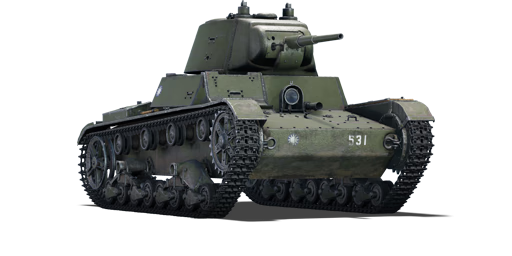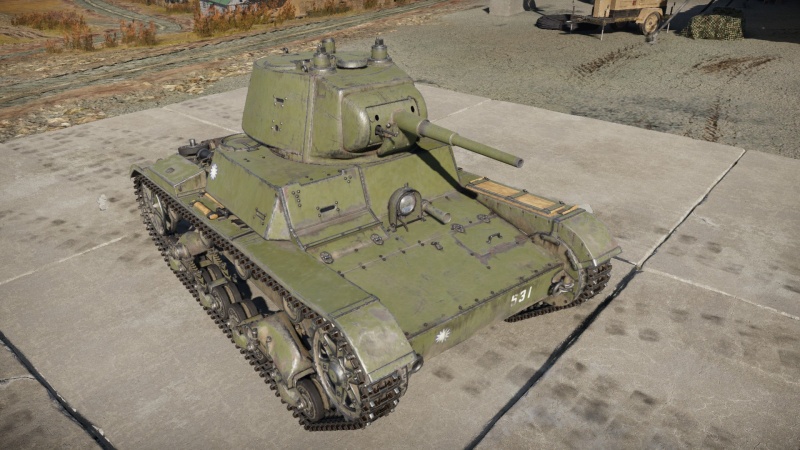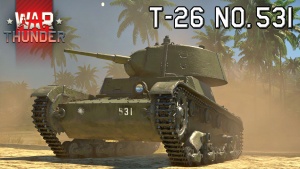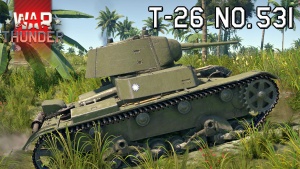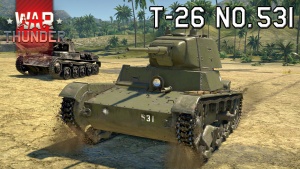Difference between revisions of "T-26 No.531"
(Updated format) |
|||
| Line 1: | Line 1: | ||
| − | |||
| − | |||
| − | |||
| − | |||
{{About | {{About | ||
| about = Soviet light tank '''{{PAGENAME}}''' | | about = Soviet light tank '''{{PAGENAME}}''' | ||
| Line 8: | Line 4: | ||
| link = T-26 (Family) | | link = T-26 (Family) | ||
}} | }} | ||
| + | {{Specs-Card | ||
| + | |code=cn_t_26_no531 | ||
| + | |images={{Specs-Card-Image|GarageImage_{{PAGENAME}}.jpg}} | ||
| + | }} | ||
| + | |||
== Description == | == Description == | ||
<!-- ''In the description, the first part should be about the history of the creation and combat usage of the vehicle, as well as its key features. In the second part, tell the reader about the ground vehicle in the game. Insert a screenshot of the vehicle, so that if the novice player does not remember the vehicle by name, he will immediately understand what kind of vehicle the article is talking about.'' --> | <!-- ''In the description, the first part should be about the history of the creation and combat usage of the vehicle, as well as its key features. In the second part, tell the reader about the ground vehicle in the game. Insert a screenshot of the vehicle, so that if the novice player does not remember the vehicle by name, he will immediately understand what kind of vehicle the article is talking about.'' --> | ||
| − | |||
| − | |||
The '''{{Specs|name}}''' is a premium rank {{Specs|rank}} Chinese light tank {{Battle-rating}}. It was introduced in [[Update 1.91 "Night Vision"]]. | The '''{{Specs|name}}''' is a premium rank {{Specs|rank}} Chinese light tank {{Battle-rating}}. It was introduced in [[Update 1.91 "Night Vision"]]. | ||
| Line 161: | Line 160: | ||
The lack of armour is really something to be kept in mind, even some machine guns (8mm, 12.7mm) will be able to go through you thickest pieces of armour (15mm), due to this you want to be trying your best to avoid enemy vehicles getting the first shot, driving under cover is advisable to avoid being spotted and if you spot an enemy vehicle it would be best to engage and destroy them as soon as possible to avoid them becoming a threat, due to the lack of effective armour, aircraft can also be a risk, again, staying in cover will make it more difficult for enemy vehicles to spot and engage your T-26. | The lack of armour is really something to be kept in mind, even some machine guns (8mm, 12.7mm) will be able to go through you thickest pieces of armour (15mm), due to this you want to be trying your best to avoid enemy vehicles getting the first shot, driving under cover is advisable to avoid being spotted and if you spot an enemy vehicle it would be best to engage and destroy them as soon as possible to avoid them becoming a threat, due to the lack of effective armour, aircraft can also be a risk, again, staying in cover will make it more difficult for enemy vehicles to spot and engage your T-26. | ||
[[File:No.531 screenshot 1.jpg|thumb]] | [[File:No.531 screenshot 1.jpg|thumb]] | ||
| − | In terms of the T-26's gun, there are 2 round options, the APHEBC round has 70mm best effective penetration as well as 29.26g of TNT equivalent explosive, this will allow for this round to penetrate most armour at this BR and also have good post pen damage if the fuse is set off. Second round type is an AP round, this has 73mm best effective penetration but lacks any explosive filler, this makes its post pen damage less effective than the APHEBC round. | + | In terms of the T-26's gun, there are 2 round options, the APHEBC round has 70mm best effective penetration as well as 29.26g of TNT equivalent explosive, this will allow for this round to penetrate most armour at this BR and also have good post pen damage if the fuse is set off. Second round type is an AP round, this has 73mm best effective penetration but lacks any explosive filler, this makes its post pen damage less effective than the APHEBC round. ''More'' ''info on both these rounds can be found in the "ammunition" section above''. |
| − | |||
| − | |||
| − | |||
| − | |||
| − | |||
| − | |||
| − | |||
| − | |||
| − | |||
| − | |||
| − | |||
| − | |||
| − | |||
| − | |||
| − | |||
| − | |||
| − | |||
| − | |||
| − | |||
| − | |||
| − | |||
| − | |||
| − | |||
| − | |||
| − | |||
| − | |||
| − | |||
| − | |||
| − | |||
| − | |||
| − | |||
| − | |||
| − | |||
| − | |||
| − | |||
| − | |||
| − | |||
| − | |||
| − | |||
=== Pros and cons === | === Pros and cons === | ||
| Line 239: | Line 199: | ||
===Combat usage=== | ===Combat usage=== | ||
[[File:No.531 screenshot 3.jpg|thumb]] | [[File:No.531 screenshot 3.jpg|thumb]] | ||
| − | In 1937-39, a period of high tensions between the USSR and Japan, the Soviets provided 88 T-26 M33 tanks to China. The T-26, which along with the BT tanks would constitute three-quarters of the Soviet tank force at the start of its own war with Germany in 1941, had been developed from and was very similar to the Vickers 6-ton tank, a model which China had previously bought from Britain. With 20 of those tanks, mostly the Vickers Mark E armed with a short 47 mm gun, fighting with the 1st and 2nd Tank Battalions around Shanghai in 1937, is where most had been lost to the Japanese. The T-26s that came after appears to have been radio-equipped. They were assigned to the 1st Tank Regiment, which had elements attached to the new 200<sup>th</sup> | + | In 1937-39, a period of high tensions between the USSR and Japan, the Soviets provided 88 T-26 M33 tanks to China. The T-26, which along with the BT tanks would constitute three-quarters of the Soviet tank force at the start of its own war with Germany in 1941, had been developed from and was very similar to the Vickers 6-ton tank, a model which China had previously bought from Britain. With 20 of those tanks, mostly the Vickers Mark E armed with a short 47 mm gun, fighting with the 1st and 2nd Tank Battalions around Shanghai in 1937, is where most had been lost to the Japanese. The T-26s that came after appears to have been radio-equipped. They were assigned to the 1st Tank Regiment, which had elements attached to the new 200<sup>th</sup> (Motorised) Division, the first such division in the Chinese army. The 200<sup>th</sup> Division, with at least nine T-26s, was deployed to Burma in the spring of 1942. Most of its tanks were believed lost in that campaign, although they acquitted themselves well. Other T-26 elements saw action in China proper throughout the war. |
This particular T-26, the T-26 No. 531, was the commander tank of general Sun Li-jen, who was nicknamed "Rommel of the east". | This particular T-26, the T-26 No. 531, was the commander tank of general Sun Li-jen, who was nicknamed "Rommel of the east". | ||
Revision as of 13:44, 28 December 2020
| This page is about the Soviet light tank T-26 No.531. For other uses, see T-26 (Family). |
Contents
Description
The T-26 No.531 is a premium rank I Chinese light tank with a battle rating of 1.0 (AB/RB/SB). It was introduced in Update 1.91 "Night Vision".
General info
Survivability and armour
This is definitively the worst characteristic of this vehicle; armour is flat and thin on all sides. Do not expose yourself to enemy fire. Crew placement is not lined up from the front, meaning shells without HE filler can take up to 3 shots before being destroyed. Beware of HMGs and autocannons, since they will be able to penetrate your armour.
Armour type:
- Rolled homogeneous armour
| Armour | Front | Sides | Rear | Roof |
|---|---|---|---|---|
| Hull | 15 mm (22°) Front plate 7 mm (64-80°) Front glacis 15 mm (6-52°) Lower glacis |
15 mm (21-23°) Top 15 mm (0°) Bottom |
15 mm (0°) Top 15 mm (12°) Bottom |
10 mm Hull 6 mm Rear |
| Turret | 15 mm (13-15°) Turret front 15 mm (5-44°) Gun mantlet |
15 mm (17-19°) | 15 mm (17°) | 10 mm |
Notes
- Suspension wheel is 10 mm thick while tracks are 15 mm thick.
- Belly armour is 6 mm thick.
Mobility
| Game Mode | Max Speed (km/h) | Weight (tons) | Engine power (horsepower) | Power-to-weight ratio (hp/ton) | |||
|---|---|---|---|---|---|---|---|
| Forward | Reverse | Stock | Upgraded | Stock | Upgraded | ||
| Arcade | 34 | 4 | 9.8 | 141 | 174 | 14.39 | 17.76 |
| Realistic | 31 | 4 | 80 | 91 | 8.16 | 9.29 | |
While being a light tank, its mobility is one of a medium. It will take you where you want to be, provided you choose your route well and avoid tricky manoeuvres. Reverse speed, while not great (-6 km/h), can save you from some bad situations, provided cover is not too far behind.
Modifications and economy
Armaments
Main armament
The 20-K is the typical Soviet rank I gun. Players should get used to it since it will be your main armament up until rank II. The APHEBC round has a good amount of HE filler, meaning penetrating shells will do good damage, sometimes even one-shotting enemies. In longer ranges, shells begin to lose penetration and accuracy; it is not made for sniping. Try to bring ~10-15 BR-240SP (pure AP shells) for heavier targets. This gun is very forgiving to beginners, with its very fast reload speed and turret traverse.
| 45 mm 20-K | Turret rotation speed (°/s) | Reloading rate (seconds) | |||||||||||
|---|---|---|---|---|---|---|---|---|---|---|---|---|---|
| Mode | Capacity | Vertical | Horizontal | Stabilizer | Stock | Upgraded | Full | Expert | Aced | Stock | Full | Expert | Aced |
| Arcade | 205 | -6°/+22° | ±180° | N/A | 15.23 | 21.08 | 25.60 | 28.31 | 30.12 | 3.77 | 3.34 | 3.07 | 2.90 |
| Realistic | 9.52 | 11.20 | 13.60 | 15.04 | 16.00 | ||||||||
Ammunition
| Penetration statistics | |||||||
|---|---|---|---|---|---|---|---|
| Ammunition | Type of warhead |
Penetration @ 0° Angle of Attack (mm) | |||||
| 10 m | 100 m | 500 m | 1,000 m | 1,500 m | 2,000 m | ||
| BR-240 | APHEBC | 70 | 68 | 59 | 50 | 42 | 35 |
| BR-240SP | AP | 73 | 71 | 62 | 52 | 44 | 37 |
| Shell details | |||||||||
|---|---|---|---|---|---|---|---|---|---|
| Ammunition | Type of warhead |
Velocity (m/s) |
Projectile Mass (kg) |
Fuse delay (m) |
Fuse sensitivity (mm) |
Explosive Mass (TNT equivalent) (g) |
Ricochet | ||
| 0% | 50% | 100% | |||||||
| BR-240 | APHEBC | 760 | 1.43 | 1.2 | 9.0 | 29.26 | 48° | 63° | 71° |
| BR-240SP | AP | 757 | 1.43 | N/A | N/A | N/A | 47° | 60° | 65° |
Ammo racks
| Full ammo |
1st rack empty |
2nd rack empty |
3rd rack empty |
4th rack empty |
5th rack empty |
6th rack empty |
7th rack empty |
8th rack empty |
9th rack empty |
10th rack empty |
11th rack empty |
12th rack empty |
13th rack empty |
Visual discrepancy |
|---|---|---|---|---|---|---|---|---|---|---|---|---|---|---|
| 205 | 202 (+3) | 197 (+8) | 187 (+18) | 177 (+28) | 167 (+38) | 157 (+48) | 139 (+66) | 121 (+84) | 103 (+102) | 79 (+126) | 61 (+144) | 29 (+176) | 1 (+204) | No |
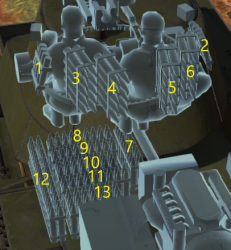
Turret empty: 157 (+48)
Machine guns
| 7.62 mm DT | ||||
|---|---|---|---|---|
| Mount | Capacity (Belt) | Fire rate | Vertical | Horizontal |
| Coaxial | 1,890 (63) | 600 | N/A | N/A |
Usage in battles
The T-26 No.531 is definitely best suited to a more support role, flanking the battlefield and finding a good position to support your teammates from, the 45mm cannon has very good characteristics with its rounds (APHEBC, AP) being able to deal fair damage to enemy vehicles from short and long-range and the fast reload allowing for quick adjustment of aim between shots, this allows the T-26 to be a highly effective flanking vehicle if a good camping spot is found, however, the limited gun depression (-6°) will affect which positions are usable, keeping long-range is certainly an effective way to avoid taking damage. The T-26 is also usable at closer ranges for brawling with enemy vehicles, but it should be kept in mind that the thin armour on the T-26 (≤15mm) will leave the vital modules of your vehicle such as your crew, gun & powerplant (engine & transmission) at risk of taking damage, the mobility of the T-26 is also lesser than many of its counterparts which could potentially put it at risk in a brawling scenario, on the other hand, the T-26's good reload (3.77 - 2.9s) will usually give it an upper hand if you can survive the first shots against an enemy vehicle.
Due to the top speed of the T-26 being less than many other vehicles at its BR (30 km/h), it will usually arrive at the battlefield after the fighting has already begun, this has the advantage of arriving after your team has already identified many targets, and also meaning that you will not be in the front line of attack, this will usually allow for you to last a bit longer than players who rushed the centre of the battlefield, alternatively, it is also less likely that you will reach capture points before they are capped by your faster teammates although there are cases where you can help capture a contested point.
It is also worth keeping in mind that the reverse speed is only 3km/h, so you will have to be careful when driving out into the potential enemy fire.
The lack of armour is really something to be kept in mind, even some machine guns (8mm, 12.7mm) will be able to go through you thickest pieces of armour (15mm), due to this you want to be trying your best to avoid enemy vehicles getting the first shot, driving under cover is advisable to avoid being spotted and if you spot an enemy vehicle it would be best to engage and destroy them as soon as possible to avoid them becoming a threat, due to the lack of effective armour, aircraft can also be a risk, again, staying in cover will make it more difficult for enemy vehicles to spot and engage your T-26.
In terms of the T-26's gun, there are 2 round options, the APHEBC round has 70mm best effective penetration as well as 29.26g of TNT equivalent explosive, this will allow for this round to penetrate most armour at this BR and also have good post pen damage if the fuse is set off. Second round type is an AP round, this has 73mm best effective penetration but lacks any explosive filler, this makes its post pen damage less effective than the APHEBC round. More info on both these rounds can be found in the "ammunition" section above.
Pros and cons
Pros:
- Great firepower; the stock shell has 69 mm maximum penetration and 32 g TNT which can frontally penetrate many tanks
- Even in an up-tier situation it can still effectively penetrate tanks like the B1
- Massive ammo capacity and fast reload time is good for new players who are learning to aim
- Premium bonuses thanks to its premium status
Cons:
- Very low survivability; the armour is thin, not angled and is only 15 mm max. Can get frontally penetrated by anything like the Pz.II, Pz.III and even heavy MG.
- The three crew members are packed tightly together significantly reduces survivability
- Poor mobility overall; has low top speed limited manoeuvrability around the battlefield, the weak engine doesn't allow it to climb hills
- The narrow tracks slow it in desert maps like Sinai or snowy maps like Frozen Pass
- The slow reverse speed of only -3 km/h is very fatal as it cannot back away from danger in time
- Average turret rotation combined with the sluggish hull traverse prevents it from responding to flanks quickly
- Average -5° gun depression limits its potential in hilly terrains
- Some ammo is stored inside turret which tends to explode when hit
History
Development
The T-26 light tank design is derived from the British Vickers 6-ton tank. In the early 1930s, a Soviet buying committee travelled to Britain and purchased tanks, tractors, and cars for use in the Soviet Union, of which the Vickers tank was chosen. Fifteen Twin-turreted Vickers tank arrived into the Soviet Union in May 1930, equipped with only machine guns. Four more Vickers were delivered at the end of 1930, these being the single-turret variants with a 47 mm gun, and the deliveries were finished by 1932. The Vickers-produced tanks were designated as the V-26.
The Vickers 6-ton tank competed with several Soviet designs for the "most suitable" tank design for Soviet use. One such competitor was the Soviet T-19 light tank, which had advantages over the Vickers design, but also disadvantages. The T-19 designer, S. Ginzburg, suggested for a "hybrid" tank to be built off the features of the T-19 and the Vickers tank. But in January 1931, intelligence picked up that Poland bought up many foreign tanks from Britain and France with a license to mass-produce them. This information pressured the Soviet military council to adopt the foreign tanks into Soviet usage, thus the Vickers 6-ton tank, under the designation as the T-26, was accepted into service on February 13, 1931, as the mainstay of the Red Army's armoured forces.
Although outclassed later in the war, it was considered one of the more successful and widely produced tank model in the 1930s. It, along with the BT light tanks, composed of the majority of Russia's armoured forces in the late 1930s. It weighed just a little under 10 tons, had 15 mm thick armour in front, with a 45 mm 20K gun, and had a crew of three people. The Bolshevik Factory in Leningrad was the first factory to start producing the T-26 from June 1931, and production of the tank lasted from then until 1941.
Variants
During its production life, many variants of it were made for different purposes, up to 53 different ones to fit different roles, though only 23 would see service in production. Such designs included changes like a twin-turreted version (some with only machine guns and some with cannons), command tanks, added armour, artillery tanks (such as the T-26-4), flamethrower tanks, remote-controlled tanks, or just armoured carriers to tow artillery and such. Others were simply modified variants of the normal variants such as the T-26E, which was the base single-turreted T-26 design with 30-40 mm applique armour made during the Winter War, which made them more resilient to the Finnish anti-tank weapons.
All these tanks produced in the span of 1931 to 1941 made up a total 10,300 tanks, and 1,701 other variants of it, for a total of 12,001 units produced.
Combat usage
In 1937-39, a period of high tensions between the USSR and Japan, the Soviets provided 88 T-26 M33 tanks to China. The T-26, which along with the BT tanks would constitute three-quarters of the Soviet tank force at the start of its own war with Germany in 1941, had been developed from and was very similar to the Vickers 6-ton tank, a model which China had previously bought from Britain. With 20 of those tanks, mostly the Vickers Mark E armed with a short 47 mm gun, fighting with the 1st and 2nd Tank Battalions around Shanghai in 1937, is where most had been lost to the Japanese. The T-26s that came after appears to have been radio-equipped. They were assigned to the 1st Tank Regiment, which had elements attached to the new 200th (Motorised) Division, the first such division in the Chinese army. The 200th Division, with at least nine T-26s, was deployed to Burma in the spring of 1942. Most of its tanks were believed lost in that campaign, although they acquitted themselves well. Other T-26 elements saw action in China proper throughout the war.
This particular T-26, the T-26 No. 531, was the commander tank of general Sun Li-jen, who was nicknamed "Rommel of the east".
Media
Excellent additions to the article would be video guides, screenshots from the game, and photos.
See also
- Standard Chinese T-26: T-26 (China)
- Standard Russian T-26: T-26
External links
Paste links to sources and external resources, such as:
- topic on the official game forum;
- encyclopedia page on the tank;
- other literature.
| China light tanks | |
|---|---|
| Type 63 | Object 211 · Type 63 · ZTS63 |
| Type 62 | Type 62 |
| WZ551 | ZSL92 · PTL02 · WMA301 |
| ZBL08 | ZLT11 |
| Type 86 | ZBD86 |
| WZ502 | ZBD04A |
| ROC | M41D · M64 |
| Type 59 | QN506 |
| USA | ␗M8 LAC · ␗M3A3 Stuart · ␗M3A3 (1st PTG) · ␗M5A1 · ␗M24 · ␗M18 GMC · ␗M41A3 |
| USSR | ␗T-26 · T-26 No.531 · ␗PT-76 |
| China premium ground vehicles | |
|---|---|
| Light tanks | T-26 No.531 · ␗M3A3 (1st PTG) · ␗M41A3 · M64 · WMA301 |
| Medium tanks | ␗M4A4 (1st PTG) · T-34-85 No.215 · Т-62 №545 · ZTZ59A · Type 69-IIa · T-69 II G · ZTZ96A (P) · Al-Khalid-I |
| Heavy tanks | IS-2 No.402 |


